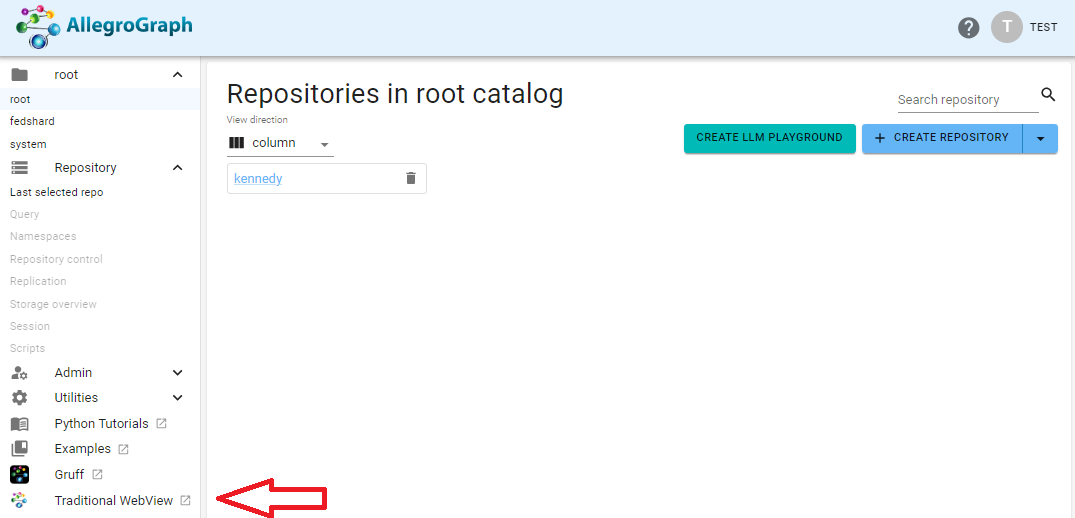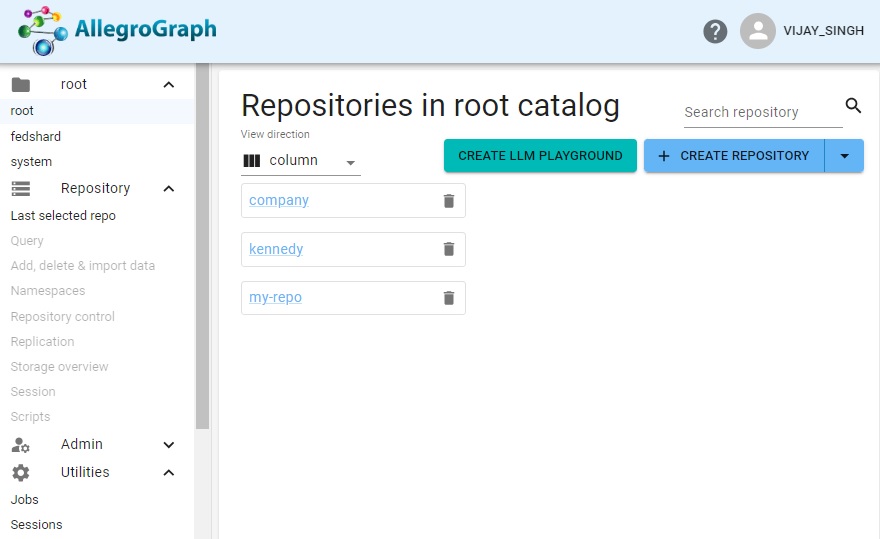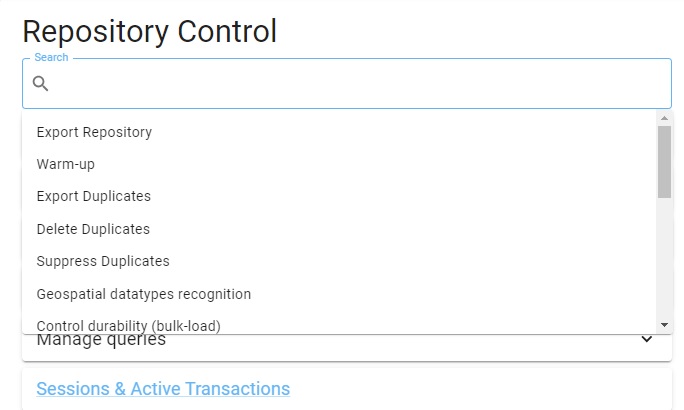Introduction
AllegroGraph has long used the AGWebView interface, described in the Traditional WebView document. AllegroGraph 8.0.1 introduces a new implementation with a new look and feel, described in this document.
New WebView is what is displayed when AllegroGraph starts up. If you would rather use Traditional WebView, click on the Traditional WebView choice in the menu on the left side of the New WebView page.

If you are using Traditional WebView, you get the new version by clicking New WebView on the right in the banner of the traditional WebView page:

Initial Display
Here is the New WebView page when it starts up:

The exact contents depend on how New WebView was initiated and characteristics and permissions of the user. Always displayed are the banner at the top and a menu list to the left. When first displayed, the main field in the center displays the repositories in the current catalog and some action buttons. Note that what works and sometimes what is displayed depends on the permissions of the current user. If the current user does not have permission to perform a certain action, that fact may be reported on the page or when the users attempts the action. Most pictures are taked when the user had superuser permission, so most illustrations in the document do not show restrictions.
The Banner
The banner, at the top of a New WebView page, is always displayed. It has three active items:
The AllegroGraph logo. Clicking on this returns to the catalog/repo page.
A ? icon: when clicked, displays a menu with choices version information and links to the documentation on the franz.com website.
A person outline icon and the current user name. These are a single active region displaying when clicked a menu of some display preferences and other actions. Warning: one of the choices is Delete. If chosen and confirmed, the current user is deleted from the system and the screen changes to a login prompt. Do not do this unless it is what you want to do.
As you navigate among the various New WebView pages, you can always get back to the catalog/repo initial page by clicking on the AllegroGraph logo on the left in the banner.
The repository page
As said, New WebView typically opens to a page listing repositories in the current catalog (usually the root catalog). Along the top to the right are button for creating a new repository in the current catalog and a button for creating an Large Language Model playground (which also creates a new repo). See the llm document for information on the llm playground.
A search widget appears on the upper right, useful when there are very many repos.
The Menus
On the left are a list of applicable menus. The list depends on the permissions of the user. For example, if the user is a superuser, one of the choices will be Admin. The arrowhead next to the menu name points down if the menu is closed and up if open. Clicking on the menu name or arrowhead changes the state.
How to use the various menu items is usually clear once the menu is displayed so we will not go into too much detail in the document.
The catalog list
Catalogs are listed under the file folder icon to the left just under the AllegroGraph icon. There is always a root and a fedshard catalog. Other catalogs must be defined by you (our your administrator) and listed in a agraph.cfg configuration file (see the Server Configuration and Control document). Clicking on a catalog name displays the repositories (also called repos) in the catalog.
The Repository Menu
The Repository menu is only active when a repo is open. Click on an existing repo listed on the page or the Create Repository box to create a new one. (Its drop down menu also allows restoring a repo from a backup file.)
Once a repo is open and the menu is live, you will see these items:
- Query: This important page allows executing queries and seeing results. Here it is after having run a query. The query shown is a useful one if you use triple attributes as it shows triples and their attributes:
![The Query page][nwv-image-example-query] select ?s ?p ?o ?attributes { ?attributes <http://franz.com/ns/allegrograph/6.2.0/attributes> (?s ?p ?o) . } Add, delete, and import data: Lists the various ways triples can be added or deleted, with links.
Namespaces: Lists available namespaces. See the Namespaces and query options document for more information.
Repository Control: One of the most important repo menu choices. It displays a number of repo-related commands, and there is a Search box for finding additional commands (clicking in it drops down a menu of choices, as shown, while typing in the box displays relevant choices based on what you type).
Storage overview: Displays graphs on storage usage by AllegroGraph.
Session: Displays information about sessions and presents a menu of actions like commit, rollback, or close. If no session is running has a button to create a basic new one and a link to a page allowing more complex sessions to be created.
Scripts: This link displays the Server Scripting page. Only users with Eval permission can write and run a script (see the Evaluate Arbitrary Code user permission in the General permissions section of the Managing Users document for information on Eval access).
Note the user in this case thinks this query so convenient that it was saved (named atts over on the right). Recent queries are listed along the top, and a selection of useful queries are listed on the right, including View triples which displays all triples (up to the specified display limit) in a repo. The display limit, on by default, is 1000, set in the In Browser Query Options to the right. See below for more information on the query page.

More on the Query page
As said above, queries can be saved. Recent queries are listed at the top of the page but these will go away unless saved (when for example, the page is reloaded).
If you hover over the Execute Button, two additional choices appear: Plan and Log. Click on Plan to see the query plan (what the system intends to do when executing the query). The plan will also display warnings if there are any. Log will cause the query ro be logged.
The Admin menu
This menu is only visible to superusers. It has the following items:
- Users: Please see the Managing Users document for further information. The AGWebView interface for controlling users (and also roles) is described in detail in that document along with the equivalent agtool users and agtool roles commands.
- Jobs: Lists running jobs. Most users do not have the necessary permissions to see the list, however.
- Requests: List of system requests. Usually useful only when there is a problem.
- Audit log: See the audit doc.
- View server log: Displays the server log.
- View and edit initfile: Changes are seen by new sessions.
- Process list: lists all running processes, providing information about them and with buttons for killing, telneting into, and the like.
- View server configuration: shows the contents of the agraph.cfg configuration file.
- View cluster configuration: if the server is part of a configuration, shows information about it. Grayed out if the server is not part of a configuration.
- WebView versions: notes the current WebView version and allows checking for newer versions.
The Utilities menu
Available to all users
- Sessions: Displays a page listing sessions and provides a link to a page allowing creation of complex sessions.
- Server stats: Displays a page of server utilization graphs. These are very useful for, among other things, seeing the space and computation resources used by a complex query.
- Geospatial datatype designer: opens the Geospatial Datatype Designer page (see the WebView Geospatial Datatype Designer section in the N-dimensional Geospatial Usage Guide and Example document.
Other items
Gruff: Open Gruff
Old WebView: Open a traditional WebView browser tab.